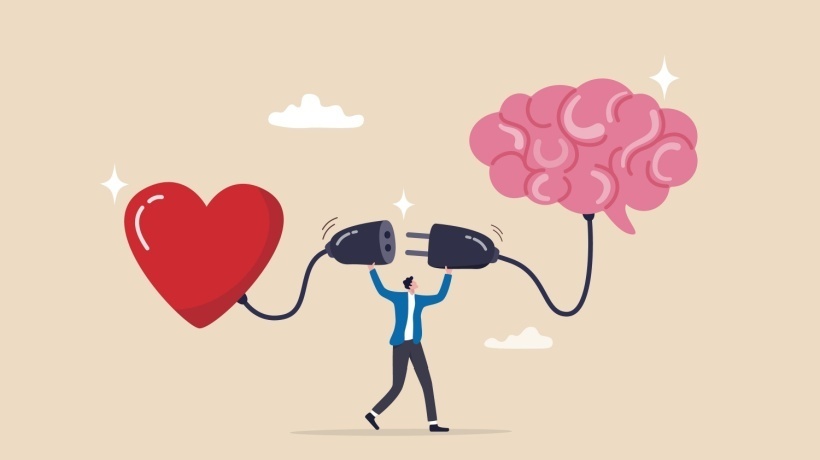The Importance And Use Of Emotional Intelligence In Learning
In 1995, Dr. Daniel Goleman—an author, scientific journalist, and noted psychologist—popularized his concept of emotional intelligence (EI; also called EQ). Dr. Goleman’s thinking on EI expanded on a related theory, advanced a decade earlier (in 1985) by Dr. Reuven Bar-On, who coined the phrase “emotional quotient” (EQ)—a set of characteristics measured by a standardized scoring system. Today, Dr. Goleman’s thoughts are a key element of applying emotional intelligence in learning.
Goleman put together a framework of 5 critical components that comprise EI. He also defined a range of additional skills that, when harnessed together, make individuals more emotionally intelligent. According to him, EI comprises 5 pillars: self-awareness, self-regulation, motivation, empathy, and social skills (more on this later).
In today’s high-strung, “always on,” and highly stressed workplace where employee mental health and overall well-being are front and center in workplace policy discussions, EI/EQ is extremely timely and relevant. That’s because Goleman concluded that EI, when applied properly, not just helps meet organizational and individual goals and aspirations but it creates a healthier, happier, and more productive workplace.
Why Should You Factor For Emotional Intelligence In Your L&D Programs?
Emotions play a key part in every aspect of our work-life equation, and emotional intelligence in learning is integral to the learning process. Armed with a degree of emotional intelligence, organizations can develop a deep understanding of their employees and what and how they like to learn. The ability of learning leaders, through their L&D programs, to empathize and relate to the learning needs of the workforce, can also help them (the leaders) foster a culture of lifelong learning across a broader base of learners in the organization.
There are challenges that businesses face if they are totally outcome-driven and do not focus on the method to achieve them. Because of how our brains function, it’s challenging (if not impossible!) to compartmentalize our cognitive and affective functions. Overly focusing on business outcomes when developing training programs risks ignoring the value that learner emotions have on achieving learning outcomes. Ignoring EI also risks stifling innovation, collaboration, and creativity among the workforce—especially in group and cooperative learning projects.
As such, understanding learner EI can help produce eLearning programs that not only focus on business outcomes but also create self-confidence and motivation-boosting learning environments. The application of emotional intelligence in learning helps build a culture of continuous learning by focusing on and understanding how emotions impact and influence our desire to learn.
How Can Emotional Intelligence Help You Transform Your Learning Programs?
-
Meaningful Connection To Learners
While learning is a cognitive function, it also involves a degree of emotion. Injecting emotional intelligence in learning design processes helps better connect learners to the learning content.
-
Fostered Flexibility, Creativity, And Resilience In The Workforce
EI-centric learning environments foster bonds of empathy and understanding between various levels of the organization. They also help L&D teams unleash creativity in building flexible learning solutions and help make employees more resilient to changes in their work and learning environment.
-
Heightened Sense Of Belonging
Emotion is a two-way street, involving giving and receiving acknowledgments and recognition. EI can help foster a sense of employees’ and learners’ belonging to the workplace by making them feel included and valued.
-
Enhanced Performance
Appreciation and recognition spur productivity. Research confirms that employees who are recognized up to six times per year show a 32% increase in performance. Highly targeted and effective learning which is tied to the learner’s needs can also drive performance.
-
Increased Staff Retention
Hiring and replacement is an expensive process. There’s also evidence that employees who receive over four awards per year are two times less likely to leave the organization. However, along with rewards and awards, an org-wide continuous learning culture also plays a big part in improving retention rates.
-
Deeper Commitment And Engagement
Emotional intelligence builds a bond between managers and the team and amongst team members. Regular (at least once weekly) check-ins with the team spur engagement levels by at least a fivefold factor. A heightened sense of engagement also fosters greater collaboration, inclusion, and personalization in learning initiatives.
-
Forces A Paradigm Shift In Employee Thinking And Motivates Them To Improve Their Behavior
Learners (and employees) who have an emotional alignment with their training content are better motivated to change their behavior and transfer their learning into the workplace. This also leads to greater motivation and better performance.
What Are The 5 Aspects Of Emotional Intelligence, And How Can L&Ds Tap Into Each One Of Them?
1. Self-Awareness
Self-awareness refers to an individual’s ability to recognize and understand one’s own emotions, strengths, weaknesses, and drives, and apply them to make apt decisions. People leaders with self-awareness take their skills and limitations into consideration when making decisions that impact their teams. Without that “awareness of self,” managers are inclined to make rash decisions, including about what L&D needs their teams to have and how best to respond to specific needs.
- Help employees become better learners by understanding their unique strengths and weaknesses. Every learner has a unique learning style and profile. Self-awareness helps organizations understand that uniqueness and leverage it to deliver better employee learning outcomes.
- Adopt a learner-centric approach to understand unique learner needs and empower them to take control of their learning experience. Using a strategy centered around emotional intelligence in learning, self-aware L&D teams can help learners focus on their individual learning needs and better manage their own learning experiences.
- Personalize the learning experience. Because EI develops a one-on-one “connection” between learners and organizations, it lends itself well to designing and developing personalized learning experiences based on unique learner needs.
- Help your learners assess themselves and build learning journeys to help them improve. Self-aware learning leaders can better lead learners on a path to personal self-awareness, especially as it relates to their own learning needs. This helps learners chart unique learning paths on their learning journey.
2. Self-Regulation
Regulating our emotions means monitoring our positive and negative feelings, hence handling difficulties without giving up. Instead of irrational reactions to genuine employee learning needs, self-regulated leaders can use emotional intelligence in learning to persevere in the delivery of thoughtful, constructive training solutions. Instead of acting irrationally, leaders must anticipate the consequences of those impulses.
- Coaching, feedback, and mentoring support employees and help them thrive.
- Integrate learning interventions that support employees at the point of need. Employees stress less about work challenges knowing that learning support to deal with those challenges is available just when and where they need it.
- Regularly connect with your learners to understand if they are fatigued or frustrated. Regular connection with your team also helps to cement their emotional bonds with the organization and its leadership.
3. Self-Motivation
Self-motivation is the ability that we have to channel our motivation and drive toward achievement. It helps L&D leaders create emotionally intelligent learning environments where learners enjoy the learning process, and it uses emotional factors to accomplish their learning objectives. It also drives affirmative change in an employee’s thinking, which results in positive behavioral changes in the workplace.
- Support employees to build a growth mindset. Self-motivated, emotionally intelligent learners continually seek to grow. EI helps build a continuous, lifelong learning mindset and is a catalyst for encouraging deeper engagement with the organization.
- Create safe practice zones to allow employees to express themselves and fail without being judged. This “forgive, forget, move on” mindset encourages learners to also provide constructive feedback on learning initiatives so L&D teams can build back better.
- Integrate learning strategies that motivate and drive employees.
- Set SMART (Short, Measurable, Achievable, Realistic, and Time-bound) goals. Goal-driven learning when aligned to learner personas can be a great motivator for self-development and drives the learner toward achieving them.
4. Social Awareness
As regards the social competence of your learners, social awareness is the ability to recognize and understand the emotions of others within social situations.
- Integrate learning programs that encourage critical thinking.
- Encourage group learning programs and collaborative learning sessions.
- Integrate diversity, equity, inclusion, and belonging (DEI&B) as a core strategy of your L&D programs so no employee feels left out of L&D opportunities.
- Ensure that learning is readily accessible at all levels throughout the organization.
5. Social Skills/Relationship Management
Social skills, or relationship management, is the ability to relate to other people in a supportive way by managing conflict. This aspect of EI helps organizations better use social situations to “nudge” learners toward the desired learning path.
- Leverage social learning. Learners learn best from other learners in their peer group. Through social learning, L&D teams can leverage the emotional bond of peer influence to edge and encourage org-wide learning.
- Leverage learning communities. Learners typically gravitate toward like-minded networks and online communities. These emotional attachments can be used by organizations as powerful learning platforms.
- Regularly provide coaching and mentoring opportunities. Self-aware and self-confident leaders can empathize and relate to their employees better than leaders who don’t possess those emotional traits. They should, therefore, use those skills to coach and mentor team members and guide them toward continuous improvement through personalized learning paths.
Parting Thoughts
According to Capgemini Research Institute, the rise of automation and AI has fueled the global demand for emotional intelligence skills sixfold. Yet, less than one in five business leaders are investing in EI. Because EI-based training is human-focused when used in an L&D context, emotional intelligence in learning helps create more learner-friendly learning solutions. As a result, EI-centered learning programs consistently produce better learning outcomes.
I hope the pointers mentioned in this article regarding EI as your learning design guiding principle provided requisite insights to help you create transformational learning. Such learning inspires employees to take on additional commitments in the workplace, motivates them to better engage with the organization, and injects a paradigm shift in employee attitudes around productivity and performance.
Read More:
- Prove And Improve: How To Measure And Demonstrate The Impact Of Your Training Programs
- Research Brief – Tying Learning Investment to Performance
- How to Get Your Employees to Learn Faster and Improve Learning Retention
- How to Design Learning Programs that Drive Employee Skill Development
- How to Drive Rapid Upskilling and Reskilling Effectively at Scale



![Emotional Intelligence And Workplace Learning - The What, Why, And How [eBook Launch]](https://cdn.elearningindustry.com/wp-content/uploads/2022/12/Shutterstock_1029532522.jpg)





